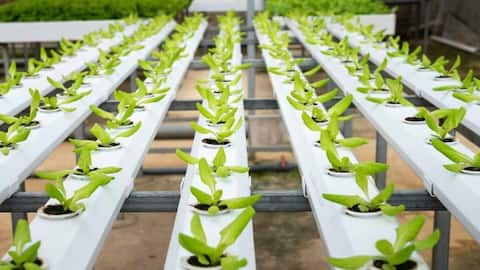Aquaponics: Understanding this sustainable farming approach
What's the story
Aquaponics is a sustainable agricultural practice that combines aquaculture (the cultivation of fish) with hydroponics (growing plants in a soil-less medium). This innovative system creates a symbiotic relationship between fish and plants, offering a highly efficient and eco-friendly approach to food production. Let us delve into the principles, benefits, and components of aquaponics, highlighting its potential to revolutionize modern farming.
Principles
How aquaponics works
Aquaponics integrates plant and fish cultivation in a closed-loop system. Fish waste-enriched water circulates from a tank to a grow bed, where bacteria convert ammonia into nitrates. Plants absorb these nutrients, purifying the water, which returns to the fish tank. This symbiotic cycle fosters a self-sustaining ecosystem, promoting plant growth and maintaining a clean, oxygenated environment for the fish, creating a harmonious balance.
Fish selection
Chose suitable fish
Commonly cultivated edible fish in aquaponic systems include carp, catfish, trout, and salmon. For ornamental purposes, one can opt for goldfish, koi, tetras, and guppies. Additional aquatic options like shrimp add diversity to the ecosystem. Explore local pet or fish stores for fingerlings or consider reputable online aquaponics stores when purchasing, ensuring credibility and quality in your selection of fish for your aquaponics setup.
Plant selection
Choose plants based on nutrient requirement
For optimal results in your aquaponic system, choose plants based on their specific nutrient, space, and light requirements. Aquaponic systems flourish with leafy greens, herbs, tomatoes, and peppers due to their high nutrient demands, well-matched with nutrient-rich fish tank water. Plant selection hinges on nutrient compatibility, emphasizing consideration of fish waste composition and pH alignment. Adequate lighting, be it natural or artificial, proves crucial.
Techniques
Different ways to grow
Aquaponics systems commonly include design options such as media beds, nutrient film technique, raft systems, and hybrid setups. Essential components encompass tanks, pumps, grow beds, and piping, with their size determined by the scale of the aquaponic system you intend to establish. Additionally, monitoring water quality parameters and ensuring a proper balance between fish waste and plant nutrient uptake is vital for system success.
Challenges
Set up cost
High setup costs for components like fish tanks and grow beds is a challenge. Technical knowledge is crucial, requiring an understanding of complex interactions among fish, plants, bacteria, and water chemistry. Achieving a harmonious balance in the system is challenging, with potential disruptions due to fluctuations in water parameters, such as pH, ammonia, and nitrate levels, leading to stressed fish and suboptimal plant growth.
Right fish
Choosing right fish
Aquaponics suitability varies among fish species. Opt for fish based on their adaptability to the aquaponic environment. Regional factors and local regulations should guide your decision. Align the chosen species with your location's temperature and consider growth rate and waste production. Faster-growing fish may increase waste, influencing nutrient levels in the system, so thoughtful consideration is necessary for a well-balanced aquaponic setup.
Benefits
Food security
Aquaponics addresses food security by harmonizing fish and plant cultivation for efficient resource use, producing both protein (fish) and produce (plants). Overcoming seasonal constraints, this method facilitates year-round crop growth indoors. Also, aquaponics stands out for its minimal environmental impact, conserving water, reducing waste, and eliminating the necessity for synthetic fertilizers and pesticides making it an eco-friendly solution for sustainable and resilient food production.
